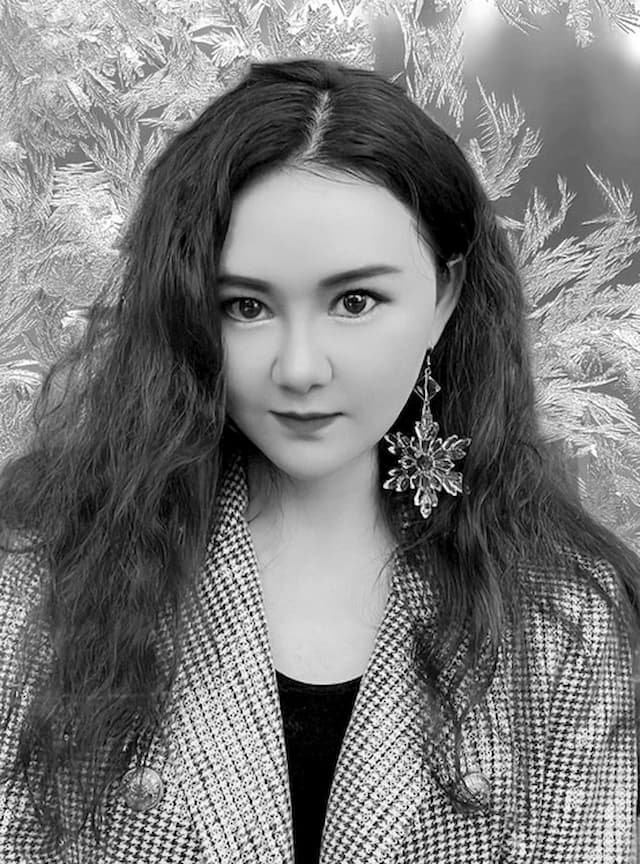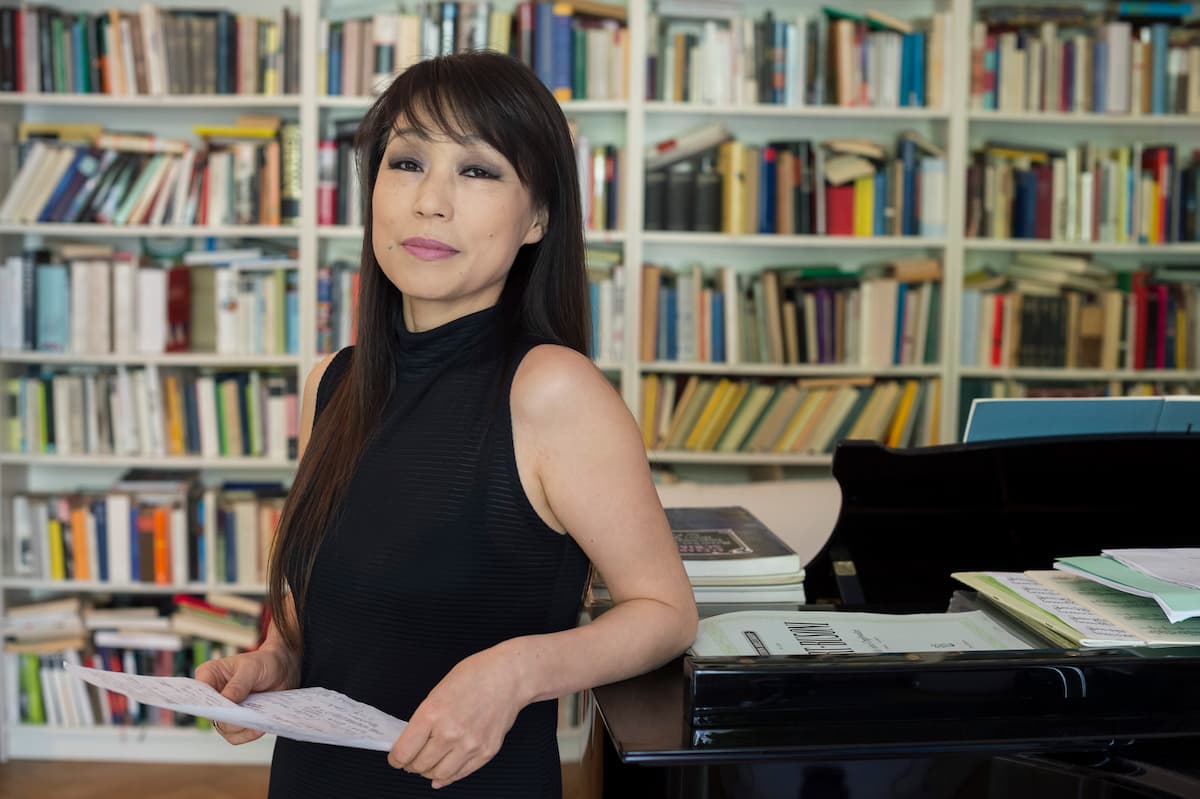Composer Sylvia Lim is a UK-based composer, whose works are known for being ‘intimate, exploring a small amount of material in depth.’ Her music has been performed by Plus-Minus Ensemble, CoMA Singers, Liam Byrne, Ben Smith, Natasha Zielazinski, Musarc, Fournier Trio, and members of the Aurora Orchestra, and recent commissions include Art Nova & Riot Ensemble, EXAUDI, and Prague Quiet Music Collective.
Given the precision demanded by her works, Sylvia often works closely in conjunction with the performers themselves, to search for the specific sounds she’s after in any given composition of hers. Sylvia’s music explores the spaces between the cracks of what we hear, delving into fragile, glistening, sometimes unpredictable sound worlds.

Sylvia Lim © Nina Close
I was lucky enough to premiere a piece by Sylvia earlier this year: Kite (Dymchurch), based on the image of a lone kite floating in the wind on a desolate shoreline in southern England. Her works often feature soft dynamics and explorations of a few well-chosen effects, be they multiphonics, drones, or harmonics, among many others. The effect is hypnotic and fascinating.
Sylvia Lim: flicker
This style did not manifest itself overnight, however; it emerged during Sylvia’s studies at the Guildhall School of Music and Drama in London. I chat to her about how this change came about, along with what fascinates her about the delicate sounds within her works.
How did your composing journey begin?
I used to record little bits and pieces of pop songs – I’d write my own lyrics and try and make little songs when I was a child. I was also really interested in musicals, so in high school, I got together with some friends and we wrote a musical together to put on in school.
I think the best bit about it was spending time with other people, writing together, and seeing it brought to life by friends. I think that was a really special time.
I wanted to study at Guildhall because I thought I could have more opportunities to look into theatre because of the drama department there, but then I kind of went in a different direction.
Did your earlier experiences with musicals sow the seed for your love of collaboration?
I think so, yes. But even though I’ve moved away from musicals I think the collaboration part, having an exchange with other people, is still important to me because you can be led in so many different directions that way, and be opened up to new ideas.
I really enjoy working with visual artists and choreographers, but also working with musicians, because the sounds I’m interested in are so variable, depending on the person.
Often there might be an idea I come to the musician with, so maybe trying out some specific sounds, but then often the most exciting sounds are the ones that emerge in a workshop or just in conversation.
When we’re actually looking for something but then we find something else – I think that’s the best bit, because I didn’t think of it beforehand, and it wouldn’t have gone into the piece if I didn’t work with this particular musician. I think that’s pretty special for me.
What brought about your change of direction as a composer?
I was in the Guildhall library one day – procrastinating – and I was walking down the corridors in the poetry section. I came across this poet called Amanda Dalton, and it was an anthology called How to Disappear. There were these beautiful poems about fading in lots of different senses of the word.
It was my first time being away from home – I’m from Australia but also grew up in Malaysia – so going to different countries and having to leave things and people behind is quite a familiar part of my life, and I think at that point I was thinking a lot about home and migration and things like that.
I think because of those experiences I started becoming really interested in memory and in decay, and I think over time I just found more and more people who were interested in that – visual artists who really inspired me, people like Do Ho Suh and Rachel Whiteread, who have all these beautiful artworks of domestic objects, like doors or houses – and that really inspired my work.
I think it pushed me to make things that were a bit more fragile and delicate, a bit more suspended and maybe not fully present. I think a few years ago I maybe would have made things that were more about absence but I feel like now I’m more interested in somewhere in-between something that’s still fragile but that feels rich.
A few years ago I did my Doctorate in decay, so looking at things like rust and mould, and how I can reflect that in sound. I feel like I’m naturally drawn to sounds now that feel a bit more grounded in some way in the natural world, whether it’s by changing every time it’s played or by having some kind of coloristic richness about it. I think that’s what I’m trying to move towards.
Your piece Kite (Dymchurch) focuses on something man-made but interacts with nature in a very direct way. How much do material things inspire you alongside nature?
I think the things that are man-made that inspire me tend to be quite close to nature or are dependent on nature – so with the kite, even though it’s man-made, it relies on the wind for it to function.
Things that are man-made that I’m drawn to tend to be quite minimal in their craft, as though they could be blended into the natural environment. So maybe I’m interested in framing.
Speaking of framing and finding sounds with players, I’m interested in things that are already formed. Sounds like multiphonics or certain sounds on instruments come with their own agency. They have their own characteristics that I don’t necessarily sculpt, but I encounter them and they’re there.
Similarly, I like things that are sort of ready-made, in a way, and I feel like I’m just framing them, or putting them in combination – just putting things together, I guess!
It seems like it’s similar to finding things in nature that are already formed, just waiting there to be discovered.
I think a quote that influenced me was by Annea Lockwood. She’s a composer who made some field recordings and she said something about how she likes to work with glass because it’s already beautifully composed, and I feel like that really stuck with me because I feel like some of these sounds are already so beautiful that you don’t really need to do much to them.
There must be lots of trust there, to know the sounds already exist and that you just have to find them.
It sounds egotistical but I don’t think it is, because I’ve not made those sounds. They just exist in the instrument somewhere, so I think my composing process is almost like treasure hunting, trying to find where these sounds are located.
Does it take a lot of confidence to let go of control of the composition process in that way?
I find this balance between control and letting go is quite a tricky one, and I find that there’s that tension in my practice, because often I still have a very specific atmosphere that I want to create, and again sometimes these sounds are so changeable that sometimes what they turn into can be unpredictable but in a way that doesn’t fit with that overall atmosphere that I want.
And then it feels like I’m trying to find a way to make these changes, trying to work out how to go about that: either adjusting my feelings about these unpredictable versions of the sounds or finding ways to incorporate them so that I’m happy with them. But it feels like a weird dance.
Has it ever happened where the sound you had in your head and the sound that came out were totally different? How do you navigate that discrepancy if/when it happens?
I think the big one is changing the way I think about premieres. It’s not always possible, and it depends on resources and context, but for me, I find that the premiere, while it’s obviously exciting and amazing to hear it, sometimes feels like it takes a while to settle into a piece – both me and the performers.
I think other people work like this too, where maybe we accept that the piece has a sort of growth period in performance, and so I often change my pieces after I hear them.
One might think that’s a form of failure, in such a high-pressured environment where we want the first performance to always be perfect, but I think it’s ok. Obviously, I try to resolve any of these changes during rehearsals and workshops beforehand, but I think it’s just working with these unstable sounds.
I think it’s not reflective of the skill of anyone involved. I think it’s just because there are all these versions [of the sounds], and some of them we don’t hear until the first performance, and then it’s working out what the boundaries of those sounds are, what we’ve got to work with.
For more of the best in classical music, sign up to our E-Newsletter
Sylvia Lim: paper wings




